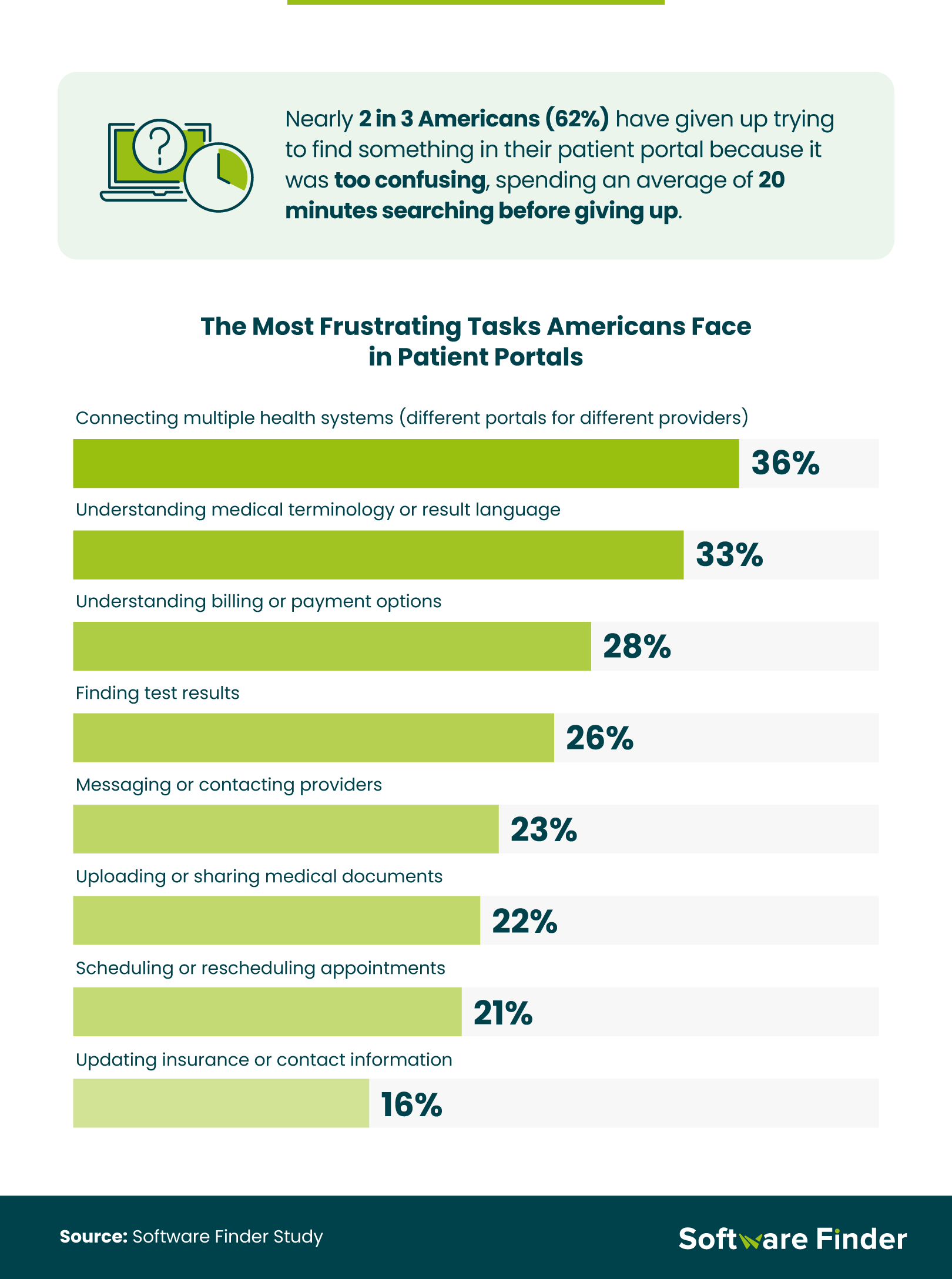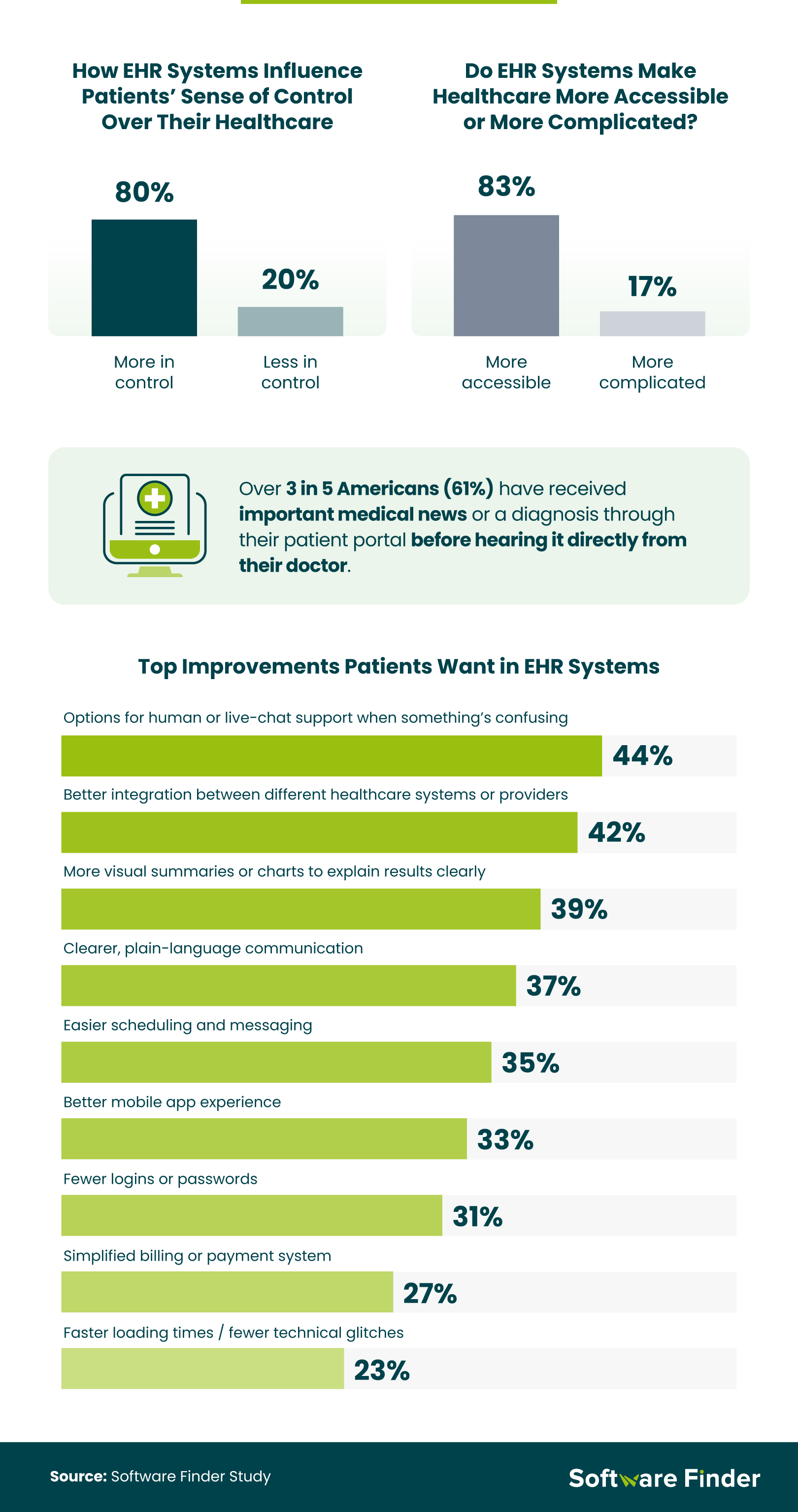Electronic health record (EHR) systems were designed to make healthcare simpler and empower patients. However, many Americans find them confusing and difficult to navigate. To better understand how well EHR systems are serving their users, Software Finder surveyed 1,000 Americans with medical conditions to measure usability, trust, and accuracy across generations. The results reveal a clear disconnect between the promise of digital healthcare and the real-world patient experience.
Navigating an EHR portal should be straightforward, yet many patients struggle to locate even basic information. The result is frustration, wasted time, and in some cases, missed medical care.

Nearly 2 in 3 Americans (62%) said they have given up searching for something in their patient portal after spending an average of 20 minutes looking. Younger generations were hit hardest, with 74% of Gen Z adults and 63% of millennials abandoning their searches, compared to 58% of Gen Xers and 40% of baby boomers. More than 1 in 4 Americans (26%) spent over half an hour searching before finally giving up, while baby boomers reported quitting after just 10 minutes, on average.
The most common pain points with EHR software included connecting multiple health systems (36%), understanding medical terminology or test result language (33%), and navigating billing or payment options (28%). Even simple tasks like finding test results (26%), messaging providers (23%), or scheduling appointments (21%) were difficult for many users.
- "If patients are spending 20 minutes just trying to find a lab result, the system isn't working for them. EHR platforms need to prioritize simplicity and ease of access," shared Adnan Malik, CEO of Software Finder. "Healthcare leaders should regularly test their portals from the patient's perspective and work with vendors to streamline the user experience."
For some patients, confusion had real consequences. Millennials (15%) and Gen Z adults (13%) were the most likely to miss or delay a medical appointment due to trouble navigating their patient portals. Roughly 1 in 5 Americans (22%) said managing their portal was more stressful than doing their taxes, a feeling shared by 22% of Gen Xers and millennials but only 16% of baby boomers.
Improving layouts and better data integration could help EHR systems serve patients more effectively, creating a smoother, more intuitive experience for all users.
EHR systems are meant to centralize care, but many Americans still find the experience fragmented and in need of refinement.

Over half of respondents (54%) reported experiencing password fatigue from managing multiple healthcare logins, and 11% required 5 or more logins just to access their medical records. Frustrated by these hurdles, nearly half of Americans (46%) resorted to screenshotting, downloading, or writing down their lab results out of fear they might lose access. Younger generations were the most proactive, with 60% of Gen Z and 47% of millennials backing up their records compared to just 21% of baby boomers.
- "When people start screenshotting their own medical records out of fear they'll lose access, that's a red flag," said Shane Elahi, COO of Software Finder. "We need to make digital healthcare feel secure, not stressful."
Concerns over accuracy and data security further undermine confidence in EHR systems. Nearly 1 in 3 Americans (31%) have found an error in their electronic medical record, such as incorrect medications, allergies, or diagnoses. Gen Z (37%) and Gen X (36%) were the most likely to discover mistakes, while fewer than 1 in 5 baby boomers (18%) reported the same. Around 1 in 4 Americans (27%) expressed doubts about the privacy and security of their health information, with millennials reporting the highest level of concern.
Trust is also strained by uncertainty around automation. Nearly half of Americans (44%) said they would prefer a human to review their records for accuracy, while another 44% favored a balance between human and AI review. More than half (52%) said they believe automation is already being used in their records without their consent.
These concerns extend to how medical data might be used outside of care. More than 1 in 3 Americans (36%) believed their records had been used to target them with ads or influence insurance pricing. Gen Z (39%) and millennials (38%) were significantly more likely to suspect this than baby boomers (23%)
Addressing these concerns through stronger data transparency and simplified access could help rebuild trust and encourage more patients to actively engage with their EHR systems.
Despite widespread frustration, most Americans remain optimistic about the potential of EHR technology.

Across generations, a strong majority (80%) said EHR systems make healthcare more accessible, including 84% of millennials and baby boomers and 81% of both Gen X and Gen Z. In addition, 80% said that EHRs make them feel more in control of their healthcare.
However, accessibility comes with new challenges. More than 3 in 5 Americans (61%) said they had received important medical news or a diagnosis through their patient portal before hearing it from a doctor. This was especially common among baby boomers (66%) and Gen Xers (65%), showing how portals have become the first point of contact for critical information.
When asked how EHR systems could be improved, users were clear. Nearly half (44%) wanted access to human or live-chat support when something is confusing, while 42% wanted better integration between different healthcare systems. Other top priorities included visual summaries or charts to clarify results (39%), plain-language communication (37%), and easier scheduling and messaging features (35%).
Generational preferences also showed distinct patterns:
- Baby boomers preferred live-chat support (49%), better system integration (48%), and more visual result summaries (32%)
- Gen X focused on live-chat support (51%), more visual result summaries (43%), and better system integration (42%)
- Millennials wanted better system integration (44%), live-chat support (40%), and plain-language explanations (38%)
- Gen Z prioritized more visual result summaries (42%), live-chat support (40%), and a better mobile experience (39%)
Patients across all generations want EHR systems that feel human, personalized, and trustworthy. The path forward requires blending accessibility with empathy, ensuring technology simplifies care rather than complicates it.
- "Patients are asking for plain language, live support, and better integration. These are not advanced features, they're the foundations of a user-friendly experience," explained Marium Lodhi, CMO of Software Finder. "Healthcare organizations should view these requests as essential upgrades, not optional add-ons, if they want to build lasting trust in their digital tools."
EHR systems were intended to make healthcare management seamless, but the patient experience often tells another story. Many Americans still struggle with confusing designs, privacy concerns, and a lack of trust in digital care systems. Yet, the data also shows optimism. Patients see value in these tools and want improvements that make them more human-centered, secure, and easy to use.
Methodology
For this study, we surveyed 1,000 Americans with medical conditions across the United States to evaluate how well electronic health record (EHR) systems actually serve patients. Respondents were asked about the usability, trust, and accuracy of their EHR portals, including their experiences accessing test results, scheduling appointments, reviewing medical information, and identifying potential record errors. The survey also examined how confidence in EHR accuracy and ease of use varied across demographics to reveal which patient groups feel most empowered or left behind by digital health systems.
About Software Finder
Software Finder helps healthcare organizations confidently choose the right EHR solution. Our expert insights, in-depth reviews, and personalized recommendations make it easy to compare top platforms by key features like patient portals, interoperability, and e-prescribing. Whether upgrading an existing system or exploring new AI-powered options, we streamline the selection process so providers can find technology that fits their workflows, compliance standards, and patient care goals—driving better outcomes and stronger engagement.
Fair Use Statement
This content may be shared for noncommercial purposes only. Please include a link to Software Finder to provide proper attribution when referencing or republishing any part of this study.
